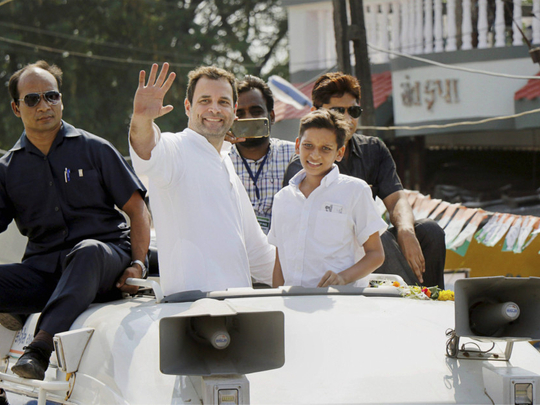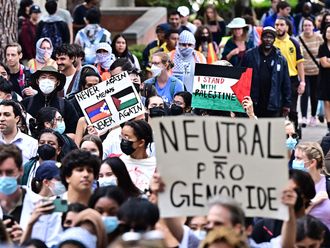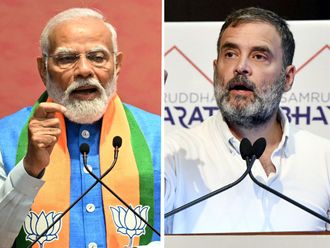
One of the oddities of the current political scene in India is the compliments that the Shiv Sena [a far-right Hindu organisation] has been paying to [Congress party vice-president] Rahul Gandhi.
The party’s spokesman, Sanjay Raut, noted recently how the Congress leader’s “body language” has changed for the better and expressed faith in his credentials to lead the country since the Modi wave has “faded away”.
As an ally of the Bharatiya Janata Party (BJP), the Sena wouldn’t have been expected to be so forthcoming in its admiration for Rahul, even if it has come to regard the BJP as an enemy, as Raut has said, and called it “ghotalebaaz”, or scamster, in a booklet.
The Sena’s latest position is more suprising because it is not considered close to the Congress, although a BJP leader has said that the Sainiks (Shiv Sena party workers) have always had a soft corner for the Congress ever since their supremo Bal Thackeray had supported the imposition of Emergency in 1975 by former Congress leader and prime minister Indira Gandhi. The Sena did support the Congress’ presidential candidate, Pratibha Patil, in 2007, instead of the BJP’s Bhairon Singh Shekhawat because she is Marathi, which is the only thing that counts for the Sena.
But hailing Rahul as a possible prime minister denotes a completely different approach unless the Sena plans to walk out of the alliance with the BJP in Maharashtra and at the Centre. Considering that the Sena chief, Uddhav Thackeray, has called upon his partymen to prepare for elections, the possibility of a formal rupture between the two saffron outfits cannot be ruled out, although the Sena has been blowing hot and cold for quite some time.
In fact, the Sena has never taken kindly to the BJP replacing it as the No 1 party in Maharashtra in 2014, since it apparently regards that position along with the chief minister’s post as its birthright in case the Hindutva (Hindu nationalist) group wins. The Sena is also aware that the BJP looks upon it as a burden of sorts because of its rough-and-ready ways that can turn off some of the “national” party’s more urbane followers.
But if the two have remained together despite the strains in their relationship, the reason is the fear that a break-up will only help the Congress.
The Sena, on the other hand, has come to believe that the BJP of today is not the BJP of 2014, although it may not go as far as Raj Thackeray of the Maharashtra Navnirman Sena (MNS) to say that the BJP will lose in Gujarat. It appears, therefore, that Sena is turning up the heat vis-a-vis the BJP, perhaps as a bargaining procedure, and what better way to do so than by extolling Rahul, who is gradually emerging as the BJP’s primary challenger from the opposition parties in his mother’s absence because of Congress president Sonia Gandhi’s indifferent health. The Sena couldn’t but have noted how the BJP is concentrating nearly all its attention on criticising someone whom it earlier used to derisively dismiss as the “shahzada” (king) and who was lampooned as “Pappu” by the BJP’s legion of foul-mouthed supporters in the social media.
All that satire and caricature are now very much in the past with the Congress’ own band of followers on the internet effectively countering the Hindu cyber warriors and Rahul himself giving back to his detractors in good measure. The part-time, reluctant politician seems to have come of age.
For the Sena, a BJP on the defensive is a windfall, for it will enable the party to lord over Mumbai and urban Maharashtra as before and not play second-fiddle as at present. It is obvious that the Sena and the MNS have limited ambitions. They do not look beyond Maharashtra — their state of origin, which has been their political arena since the party was formed in the mid-1960s by exploiting local sentiments and taking advantage of the Congress’ slow decline.
All that the two parties led by estranged cousins want is to be the masters of all they survey in ‘Maximum City’ and the small towns in Maharashtra. For the present, the Sena must be happy that it has an edge over the MNS, but that can change since both depend solely on the parochial Marathi vote, mainly of the lower middle class, which can hardly be considered stable.
The BJP, on its part, banks on the Hindu middle and upper middle classes and also the support of those who were expecting Prime Minister Narendra Modi to deliver on his promise of rapid development. In its absence, however, the latter will tend to drift away, leaving the BJP with the pro-Hindu and anti-Muslim voters, whom it will have to share with the Sena and the MNS. The assembly elections in several states in the coming days will show whether the Sena has read the political tea leaves right about Modi’s waning influence. But even if it has misread the scene, its praise for Rahul is noteworthy because none of the Congress’ friends on the “secular” side of the political divide — whether the Rashtriya Janata Dal or the National Conference or the Marxists — have expressed high hopes so far about the Congress vice-president’s chances as the Sena has done.
Clearly, a process of political churning is on.
— IANS
Amulya Ganguli is a political analyst.










